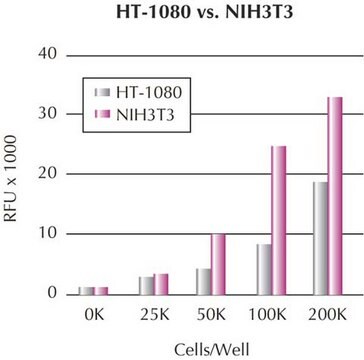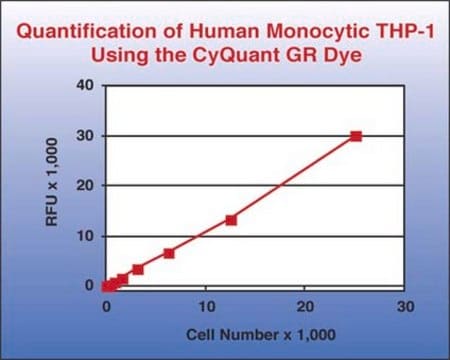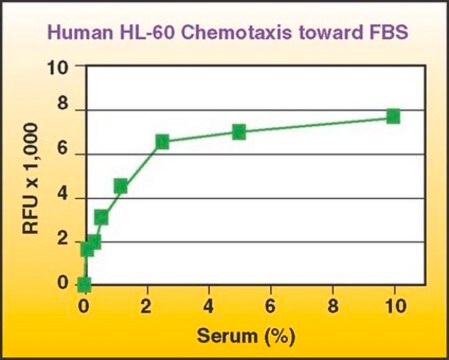ECM510
QCM Chemotaxis Cell Migration Assay, 96-well (8 µm), fluorimetric
The QCM 8 uM 96-well Migration Assay utilizes a 8 um pore size, which is appropriate for leukocyte migration.
Synonym(s):
Fluorescent cell migration assay
Sign Into View Organizational & Contract Pricing
All Photos(2)
About This Item
UNSPSC Code:
12352207
eCl@ss:
32161000
Recommended Products
Quality Level
species reactivity (predicted by homology)
all
manufacturer/tradename
Chemicon®
QCM
technique(s)
activity assay: suitable
cell based assay: suitable
detection method
fluorometric
shipped in
wet ice
Related Categories
General description
Also available: Cell Comb™ Scratch Assay! Get biochemical data from a scratch assay!
Click Here
Introduction
Cell migration is a fundamental function of normal cellular processes, including embryonic development, angiogenesis, wound healing, immune response, and inflammation. Microporous membrane inserts are widely used for cell migration and invasion assays. The most widely accepted of which is the Boyden Chamber assay. However, current methods of analysis are time-consuming and tedious, involving cotton swabbing of non-migrated cells on the top side of insert, manual staining and counting. Recently a fluorescence blocking membrane insert was introduced to address these issues; however, this approach requires labeling of the cells with Calcein-AM and extensive washing to remove free Calcein before cell migration. The effect of this treatment on cell behavior/migration remains questionable.
The Chemicon QCM<TMSYMBOL></TMSYMBOL> 96-well Migration Assay does not require cell labeling, scraping, washing or counting. The 96-well insert and homogenous fluorescence detection format allows for large-scale screening and quantitative comparison of multiple samples.
In the Chemicon QCM<TMSYMBOL></TMSYMBOL> 96-well Migration Assay, migratory cells on the bottom of the insert membrane are dissociated from the membrane when incubated with Cell Detachment Buffer. These cells are subsequently lysed and detected by the patented CyQuant GR dye (Molecular Probes). This green-fluorescent dye exhibits strong fluorescence enhancement when bound to cellular nucleic acids.
The Chemicon QCM<TMSYMBOL></TMSYMBOL> 96-well Migration Assay provides a quick and efficient system for quantitative determination of various factors on cell migration, including screening of pharmacological agents, evaluation of integrins or other adhesion receptors responsible for cell migration, or analysis of gene function in transfected cells.
The Chemicon QCM<TMSYMBOL></TMSYMBOL> 96-well Migration Assay utilizes an 8 μm pore size, as this is appropriate for most cell types. This pore size supports optimal migration for most epithelial and fibroblast cells; however, it is not appropriate for lymphocyte migration experiments. The system may be adapted to study different types of cell migration, including haptotaxis, random migration, chemokinesis, and chemotaxis.
In addition, Chemicon also provides QCM<TMSYMBOL></TMSYMBOL> 24-well insert cell migration assay systems, CytoMatrix<TMSYMBOL></TMSYMBOL> Cell Adhesion strips coated with ECM proteins or anti integrin antibodies, and QuantiMatrix<TMSYMBOL></TMSYMBOL> ECM protein ELISA kits.
Application:
The Chemicon QCM<TMSYMBOL></TMSYMBOL> 96-well Migration Assay is ideal for the study of chemotaxis cell migration. The quantitative nature of this assay is especially useful for large scale screening of pharmacological agents. The 8 μm pore size of this assay′s Boyden chambers is appropriate for migration studies of most cell types. Each kit provides sufficient materials for the evaluation of 96 samples.
The Chemicon QCM<TMSYMBOL></TMSYMBOL> 96-well Migration Assay is intended for research use only; not for diagnostic applications.
Click Here
Introduction
Cell migration is a fundamental function of normal cellular processes, including embryonic development, angiogenesis, wound healing, immune response, and inflammation. Microporous membrane inserts are widely used for cell migration and invasion assays. The most widely accepted of which is the Boyden Chamber assay. However, current methods of analysis are time-consuming and tedious, involving cotton swabbing of non-migrated cells on the top side of insert, manual staining and counting. Recently a fluorescence blocking membrane insert was introduced to address these issues; however, this approach requires labeling of the cells with Calcein-AM and extensive washing to remove free Calcein before cell migration. The effect of this treatment on cell behavior/migration remains questionable.
The Chemicon QCM<TMSYMBOL></TMSYMBOL> 96-well Migration Assay does not require cell labeling, scraping, washing or counting. The 96-well insert and homogenous fluorescence detection format allows for large-scale screening and quantitative comparison of multiple samples.
In the Chemicon QCM<TMSYMBOL></TMSYMBOL> 96-well Migration Assay, migratory cells on the bottom of the insert membrane are dissociated from the membrane when incubated with Cell Detachment Buffer. These cells are subsequently lysed and detected by the patented CyQuant GR dye (Molecular Probes). This green-fluorescent dye exhibits strong fluorescence enhancement when bound to cellular nucleic acids.
The Chemicon QCM<TMSYMBOL></TMSYMBOL> 96-well Migration Assay provides a quick and efficient system for quantitative determination of various factors on cell migration, including screening of pharmacological agents, evaluation of integrins or other adhesion receptors responsible for cell migration, or analysis of gene function in transfected cells.
The Chemicon QCM<TMSYMBOL></TMSYMBOL> 96-well Migration Assay utilizes an 8 μm pore size, as this is appropriate for most cell types. This pore size supports optimal migration for most epithelial and fibroblast cells; however, it is not appropriate for lymphocyte migration experiments. The system may be adapted to study different types of cell migration, including haptotaxis, random migration, chemokinesis, and chemotaxis.
In addition, Chemicon also provides QCM<TMSYMBOL></TMSYMBOL> 24-well insert cell migration assay systems, CytoMatrix<TMSYMBOL></TMSYMBOL> Cell Adhesion strips coated with ECM proteins or anti integrin antibodies, and QuantiMatrix<TMSYMBOL></TMSYMBOL> ECM protein ELISA kits.
Application:
The Chemicon QCM<TMSYMBOL></TMSYMBOL> 96-well Migration Assay is ideal for the study of chemotaxis cell migration. The quantitative nature of this assay is especially useful for large scale screening of pharmacological agents. The 8 μm pore size of this assay′s Boyden chambers is appropriate for migration studies of most cell types. Each kit provides sufficient materials for the evaluation of 96 samples.
The Chemicon QCM<TMSYMBOL></TMSYMBOL> 96-well Migration Assay is intended for research use only; not for diagnostic applications.
Application
Research Category
Cell Structure
Cell Structure
The QCM 8 uM 96-well Migration Assay utilizes a 8 um pore size, which is appropriate for leukocyte migration.
Packaging
96 wells
Components
Sterile 96-well Cell Migration Plate Assembly: (Part No. 90128) One 96-well feeder tray, and one 96-well Cell Migration Chamber plate. Area = 0.3 cm2, 50,000 cells per well
96-well Cell Culture Tray: (Part No. 90129) One 96-well feeder tray.
Cell Detachment Solution: (Part No. 90131) One bottle - 16 mL.
4X Cell Lysis Buffer: (Part No. 90130) One bottle - 16 mL.
CyQuant GR Dye: (Part No. 90132) One vial - 75 μL
96-well Cell Culture Tray: (Part No. 90129) One 96-well feeder tray.
Cell Detachment Solution: (Part No. 90131) One bottle - 16 mL.
4X Cell Lysis Buffer: (Part No. 90130) One bottle - 16 mL.
CyQuant GR Dye: (Part No. 90132) One vial - 75 μL
Legal Information
CELL COMB is a trademark of Merck KGaA, Darmstadt, Germany
CHEMICON is a registered trademark of Merck KGaA, Darmstadt, Germany
Disclaimer
Unless otherwise stated in our catalog or other company documentation accompanying the product(s), our products are intended for research use only and are not to be used for any other purpose, which includes but is not limited to, unauthorized commercial uses, in vitro diagnostic uses, ex vivo or in vivo therapeutic uses or any type of consumption or application to humans or animals.
Signal Word
Danger
Hazard Statements
Precautionary Statements
Hazard Classifications
Aquatic Acute 1 - Aquatic Chronic 2 - Eye Dam. 1
Storage Class Code
10 - Combustible liquids
WGK
WGK 3
Certificates of Analysis (COA)
Search for Certificates of Analysis (COA) by entering the products Lot/Batch Number. Lot and Batch Numbers can be found on a product’s label following the words ‘Lot’ or ‘Batch’.
Already Own This Product?
Find documentation for the products that you have recently purchased in the Document Library.
Customers Also Viewed
Zhaolu Wang et al.
Journal of cerebral blood flow and metabolism : official journal of the International Society of Cerebral Blood Flow and Metabolism, 32(2), 387-398 (2011-11-03)
Ischemic stroke affecting the adult brain causes increased progenitor proliferation in the subventricular zone (SVZ) and generation of neuroblasts, which migrate into the damaged striatum and differentiate to mature neurons. Meteorin (METRN), a newly discovered neurotrophic factor, is highly expressed
Nadia K Guimaraes-Souza et al.
Nephrology, dialysis, transplantation : official publication of the European Dialysis and Transplant Association - European Renal Association, 27(8), 3082-3090 (2012-01-31)
Recent advances in cell therapies have provided potential opportunities for the treatment of chronic kidney diseases (CKDs). We investigated whether human kidney structures could be preformed in vitro for subsequent implantation in vivo to maximize tissue-forming efficiency. Human renal cells
Rishipal R Bansode et al.
International journal of biological sciences, 7(5), 629-644 (2011-06-08)
The activity of N-hexanoyl-D-erythro-sphingosine, a C6-ceramide against angiogenesis was tested in vitro and in vivo. The effect of ceramide in inhibiting MCF-7 cancer cells was also determined. The aim of this study was to potentiate the effect of ceramide as
Hiroki Ono et al.
Arteriosclerosis, thrombosis, and vascular biology, 24(9), 1634-1639 (2004-07-10)
Migration of vascular smooth muscle cells (VSMCs) contributes to formation of vascular stenotic lesions such as atherosclerosis and restenosis after angioplasty. Previous studies have demonstrated that tumor necrosis factor-alpha (TNF-alpha) is a potent migration factor for VSMCs. cAMP-response element-binding protein
Janette M Birmingham et al.
Carcinogenesis, 30(4), 690-697 (2009-02-18)
Adipose tissue secretes factors linked to colon cancer risk including leptin. A hallmark of cancer is sustained angiogenesis. While leptin promotes angiogenesis in adipose tissue, it is unknown whether leptin can induce epithelial cells to produce factors that may drive
Our team of scientists has experience in all areas of research including Life Science, Material Science, Chemical Synthesis, Chromatography, Analytical and many others.
Contact Technical Service








